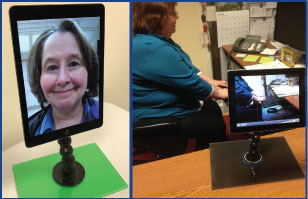Grappone Conference Center
70 Constitution Avenue
Concord, NH 03301
United States
 Everyone benefits from using remote video interactive services whether on the receiving or the delivery end.
Everyone benefits from using remote video interactive services whether on the receiving or the delivery end.
Interactive video options like FaceTime, Skype, Zoom, and Google Hangouts have become popular and easy to use solutions for providing and receiving remote assistive technology services. The use of remote services can help to maximize assistive technology services at home, school, work, and play.
Some examples of how remote services can be beneficial include:
- Providing instant access to assistive technology consultants nationwide;
- Providing remote interpreting;
- Alternative education options for students who want to participate in the classroom but are unable to do so because of medical or behavioral challenges;
- A means for learning how to set up a device via a remote consultant walking you through the steps;
- Receiving a remote assistive technology assessment;
- Making remote observations or consultations;
- Receiving a demonstration on the use of an assistive technology device;
- Conducting or receiving remote assistive technology workshops; and
- Learning how to build an assistive technology device.
This workshop will help you to develop your own ideas for using interactive video conferencing to personalize your AT services, save professional time, reduce the miles you drive and expand the reach of your AT offerings.
As an added bonus, Dr. Therese Willkomm, the MacGyver of assistive technology, will lead a make-and-take activity in which each person will create their own multiuse video presenter stand – a portable, collapsible, multiuse stand than can be used in at least 10 different ways to provide remote assistive technology services – valued at $50.
Agenda
- Introductions and Overview of the Day
- Overview of remote services that use interactive video: What we have learned so far
- Remote services “smack down”: Examples of the use of interactive video for AT
- Activity: Brainstorming your use of interactive video
- Considerations for planning and implementing remote services
- Activity: Planning your use of interactive video
- Personal planning for your own remote applications
We will begin by discussing the provision of remote AT support services, explore research about effective provision services using interactive video, and explore many examples of the ways AT providers can use video conferencing to enhance their work. Examples will include strategies for AT assessment, consultation, collaboration, and coaching as well as the provision of direct support for families, students, and staff.
When plans for remote services have been made, it’s just the beginning. Participants will use their initial explorations to think about the physical and technology resources they will need as well as time, personnel and administrative supports that will help ensure sustainability.
Once we have explored the characteristics of high quality remote AT services and have seen a variety of examples, participants will go to work on their own application ideas. You will choose a focus such as coaching with interactive video or technical assistance for AT and begin to make a plan for implementation. Participants will have an opportunity to present their plan remotely using the ZOOM video conferencing platform. Come prepared to be creative!
Who Should Attend
Teachers, special educators, inclusion facilitators, paraprofessionals, occupational therapists, speech and language pathologists, and physical therapists.
Presenter
Gayl Bowser, M.Ed. works as an independent consultant and is an adjunct faculty member for the University of Wyoming’s Wyoming Institute for Disabilities (WIND). Her work focuses on the creation of effective, legal and high quality service systems that encourage the integration of technology into educational programs for students with disabilities. Ms. Bowser has worked as a Regional and State-level administrator in Oregon. Formerly the Coordinator of the Oregon Technology Access Program (OTAP) and the State of Oregon’s Specialist in Assistive Technology, Gayl currently provides assistive technology consultation, training and technical assistance throughout the United States and internationally. Gayl has co-authored numerous publications about assistive technology including Quality Indicators for Assistive Technology: A comprehensive guide to assistive technology services; Education Tech Points: A Framework for Assistive Technology; and Assistive Technology Pointers for Parents.
$125
Group rate: Every fourth person from the same school or organization registers for FREE.
IOD Events
contact.iod@unh.edu
603.228.2084
